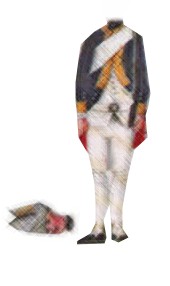
THE H E A D L E S S
H E S S I A N(S)
of Red Bank
(Fort Mercer)
New JerseyMy thanks to Joyce Stevenson, of Mullica Hill, N.J., for providing a copy of this story to me.
STORY OF THE HEADLESS HESSIAN
Author Unknown
[Slightly edited by the webmaster]
Count Kurt von Donop was sent from Philadelphia with four batallions of picket Hessians, 2000 strong to New Jersey. This was in preparation on their way to Red Bank [in Gloucester County, N.J.]. They came to Haddonfield in the evening of October 21 where they bivouaced for a short time. They went off in the night and proceeded down to the fort. On their way they took prisoner every person they thought might give information of their movements ("Const. 3 III 1846; vol 12, 32 wh 602--Fithian, Jos. Col.; p. 1. col 2).
The group travelled over the old Hessian Road, as it is now called, on their way to the Fort [Fort Mercer]. "It crosses the head of a stream that runs up in the country called Hessian Run," named for a soldier, a Hessian, who had been left wounded by his comrades near by" (Ib. 17 II 1846; vol 12 #30 wh 600 p1 col 3; Fithian Col.)
Count von Donop, with his small army, came to the edge of the woods at Fort Mercer on the morning of October 22 and stopped within cannon shot where the line of battle was formed. The small garison [garrison] of 400 within the Fort under the command of Lieutenant Colonel Christopher Greene consisted of two regiments from Rhode Island belonging to Varnum's Brigade, had expected no land attack. Their sentry lines did not even extend beyond the fortification. There were the sixty-four ships that grimly swung at anchor against the green shore of the Delaware. With only fourteen cannons mounted and the feeble earthworks, Colonel Greene was not dismayed with his three hundred. Preparations were ordered at once for the defence with the guns "double shotted and primed." There was a hurrying footfall of the men forming their line along the parapets; there was the rattling of snapping flints, the clash of steel, the tatoo of the ramrods--calling to quarters, and the roll of the drums.
Without was the roll of the Hessian drums with a slight silence as though the men were saying their last prayers. The Hessian officer, with an aid [aide] bearing a flag of truce, advanced from out of the wood, and crossed the open field, followed by a drummer. Tauntingly the drummer's sticks fourished upon the drumhead when Colonel Greene leaped upon the earthworks. The Hessians were suffered to approach, but his insolent harrangue irritated the garison [garrison], and inspire them the more to do battle. Bellowed the officer, "The king of England orders his rebellious subjects to lay down their arms; and they are warned, that if they stand battle, no quarters whatever will be given." Colonel Greene accepted the challenge for himself and his men. "We ask no quarters, no will we give any," was flung back to the advance guard.
The attack began at once, at four o'clock in the afternoon, just as soon as drummer and officer had returned to the lines. Within the Fort all were eager and busy. The out-works were still unfinished, and Greene, with his men, relied mainly upon the strength of the inner redoubt. The Americans withdrew from the out-works, leaving them abandoned.
"The Hessians made a very brisk fire from a battery of cannon." (B & Hill). They had connonaded the place to make a breach in the walls. At the end of three-quarters of an hour, the cannonading ceased. A battalion of the tall-helmeted Hessian swept to the attack of the entrenchments, they had imagined that the Americans had been driven therefrom. They swept to the attack, both north and south of the Fort. Suddenly "they were overwhelmed with a shower of musket shot, which took them in the front and in flank...officers were seen rallying their men, marching back to the abattis, and falling amidst the branches they were endeavoring to cut." (B&H ibid).
When the storming and attacking party reached the face of the bank, to clamber over the rampart, there came from the ambrassures in front, there from the half-masked battery in the flank, an awful storm of musket balls and crape shot. Greene's forces had held their fire until their musket charges were driven into the faces and breasts of the Hessians. These it seems were swept and blown back to the out-works like chaff in the wind.
"At length they relinquished the attack, and regained the wood in disorder." (B & H. F.). These retreating Hessians left their dead and bleeding practically in heaps. "M. de Mauduit. . . sallied out with a detatchment, and it was then he beheld the deplorable spectacle of the dead and dying, heaped one upon another." (B. & H. ib). Count von Donop fared no better. He, with his men, pressed the abattis and faced the fire on the south side. He was at first taken into the Fort and then to the Whittal House. Three days later, he passed to his fathers; his wounds had been in the hip.
The other wounded were taken "into the house of James Whitall below and adjoining the Fort, The wounded were taken there to have their wounds dressed by the Surgeon, The premises were covered with the poor fellows. The desperately wounded were arranged in rows in the lower rooms; those for whom hope was entertained, were removed to the upper rooms for treatment. (Const. $ II 1846; Vol 12 #31. wh. 601; p1 col1 Fifth Coll). Ann Cooper Whitall was there on hand with bandages to aid the injured as they were brought in and the house was soon filled to the attic. Those that complained were admonished by her, that they ought "not complain who had brought it upon themselves."
The dead at the Fort were buried in trenches, being laid alongsided [sic] one another. Their "long queus [sic queues] and odd dress gave them a strange appearance, as they settled away in their last home... within a few years by the wearing away of the [river] bank, some of these depositaries of the dead have been exposed, and the bones discovered." (ib 17 II 1846; vol 12 #30 wh 600p coll Fifth Coll). The winters had been aided in the wearing away from the banks, so that some of the bones fell upon the river shore. It was then that fun-loving rovers would come at night "over from Babylon," as Ann was wont to call Philadelphia, and arm themselves with these bones, muttering weird cries as they chased about her home. This was to represent Hessian's madelictions [sic maledictions], and if perchance a shutter was left open, they would wrap [sic rap] on the glasses [windows] with these bones. Through these shinanigans [sic shenanigans] the place acquired the reputation it was being haunted. Ant this was most demoralizing, not only to farm help, but also to all other house help. Also, as Ann had ferretted out the origin of these vexations, she persuaded her sons to collect and rebury all visible bones left from the battle, and thus the "Haunt was laid," in short order.
Among these Hessians [reburied], there were two whose heads had been blown off. When they were interred, the head of the one was buried with body of the other, and the head of the other was buried with the body of one. This caused considerable consternation. None of these poor Hessians could sleep in their place of long rest.
This caused the two to arise on moonlit night, and wander through the countryside about the old Fort. It was reported, according to tradition, that they wandered as far as Haddonfield, far from their place of accident. Each was trying to find the other; each was attempting to locate his own head.
They wandered all over the old battle field for years, without ever meeting one another. They frightened old and young alike. Sometimes one of them appeared and a short while thereafter a second apparition, with its long clothing swaying and swinging in the moonlight, as the zephyrs gently swayed it to and fro. And after one had gone on, the other would return and fade away amidst the trees on the banks of the Delaware, then too after the disappearance of the first, the second would appear and in its phantom-like movement, would disappear.
So for years these two unfortunates wandered through meadow, woods, and floated over streams, all over the old battle ground at Fort Mercer, with an occasional glance through the windows of the Whitall Mansion and from there unto Woodbury Creek, as far as the Lowe House, where their leader Count von Donop had passed away, to be gathered until his fathers.
Years passed into decades and these into centuries. Thus for years and decades these two moved and floated over the countryside, until early of the twentieth century. One night, both met at the old spot where had sood the Lowe House, on the other side of Crown Point Road. They exchanged their heads and immediately fell into dust.

Reference | Photographs | Contact | Site Map
Copyright © 2003-2020 | Janice A. Brown | All rights reserved.
